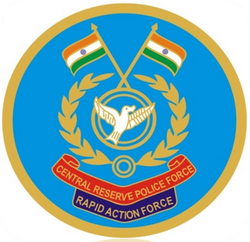Top Qs
Timeline
Chat
Perspective
Rapid Action Force
Wing of the Central Reserve Police Force of India From Wikipedia, the free encyclopedia
Remove ads
The Rapid Action Force (RAF), is a specialized rapid reaction wing of the Central Reserve Police Force (CRPF) of India established in October 1992 to deal with riot and crowd control situations.[2]
Remove ads
History
RAF was established on 11 December 1991 by the Union Home Ministry with headquarters in New Delhi.[3] It became fully operational on 7 October 1992, to deal with riots, riot-like situations, crowd control, rescue and relief operations, and related unrest.[2][4] The first five battalions were operationalized by October 1992 and an additional 5 battalions were added in April 1994.
On 7 October 2003, with 11 years of service, the force was presented with the President's Colour.[2] On 9 November 2013, the RAF Academy of Public Order was established in Meerut, Uttar Pradesh.[5][6] In 2017, the Indian government approved an additional five battalions to be based in New Delhi, Haryana, Rajasthan, Uttar Pradesh, and Bihar.[7]
Remove ads
Organisation
Summarize
Perspective
RAF is commanded by an Inspector-General of Police (IGP), functioning at New Delhi. The RAF is divided into three ranges headed by a Deputy Inspector-General of Police (DIGP) in New Delhi, Mumbai, and Dehradun. It has also a specialized training centre "RAPO" (RAF Academy for Public Order) in Meerut, Uttar Pradesh headed by a DIGP. The RAF has a distinctive uniform with a blue-coloured camouflage pattern which symbolizes peace. Its motto is "Serving Humanity with Sensitive Policing".
It currently has 15 specialized trained and equipped battalions, which are numbered 83, 91, 97, 99 to 108, 114 and 194 in the CRPF. Each battalion is headed by a Commanding Officer (CO), an officer of the rank of Commandant.[2] The RAF Battalions of CRPF are located at the following places:[8]
A team is the smallest independent functional unit of the force and is commanded by an Inspector. Each team has three components: riot control, tear smoke, and fire. Each company of RAF has one team composed of women personnel to deal with women demonstrators.[2]
The force is equipped with non-lethal weapons for dispersing the crowd with minimum harm and losses. It is always kept in readiness for rapid deployment when the situation so demands and are only deployed by the orders of Ministry of Home Affairs on specific demands from state governments for a short duration.[9]

Remove ads
Role
Summarize
Perspective
Riot and crowd control
This unit has been used to deal with communal violence, law and order duty, festival and election duties and agitation.[7]
United Nations Peace Keeping Operations
The CRPF female and male contingents under the arrangements of RAF are deployed in United Nations Mission in Liberia (UNMIL), Monrovia and Zwedru in UN Peacekeeping mission since 2007–08. CRPF Female Formed Police Unit was the first of its kind in the world, which was deployed under the aegis of UN Peace Keeping Mission.[2]
Humanitarian activities

RAF has also succeeded in projecting the human face of the Government and built bridges with the public by carrying out prompt rescue and relief operations during floods, earthquakes, cyclones and outbreak of epidemics in various parts of the country.[2]
Anti-terror operations
Kamlesh Kumari of the 88 Mahila Battalion was posthumously awarded the Ashoka Chakra for her bravery during the 2001 Indian Parliament attack.[10]
RAF was active during the 2002 Swaminarayan Akshardham temple attack in Gandhinagar, Gujarat.[11]
During the November 2008 Mumbai Terror Attacks, RAF was involved in cordoning the areas around the Oberoi Trident and the Taj Mahal hotels.[12]
References
Wikiwand - on
Seamless Wikipedia browsing. On steroids.
Remove ads

